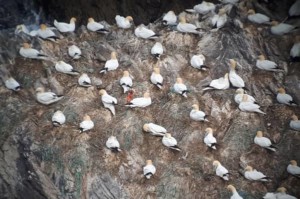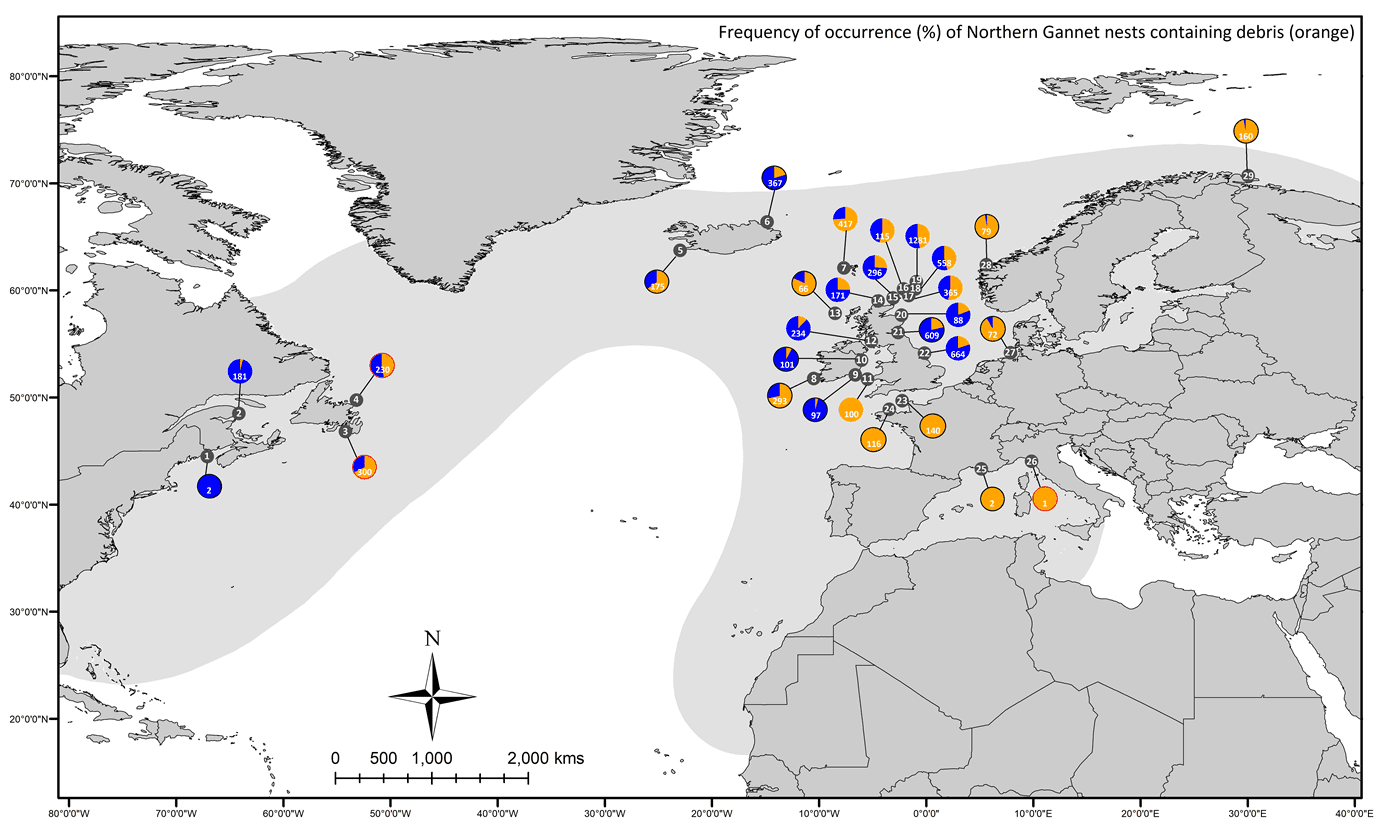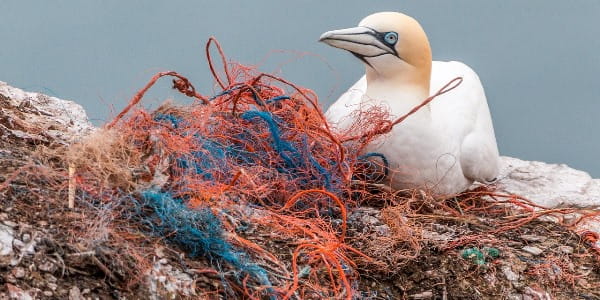LINKED PAPER
Monitoring nest incorporation of anthropogenic debris by Northern Gannets across their range. O’Hanlon, N.J., Bond A.L., Lavers, J.L., Masden, E.A. & James, N.A. 2019. Environmental Pollution. DOI: 10.1016/j.envpol.2019.113152. VIEW
A search for ‘Gannet nest’ and ‘Plastic’ on Google Images will reveal many photographs of gannet nests containing plastic. The Northern Gannet Morus bassanus colony on Grassholm, South Wales is particularly infamous for the amount of anthropogenic debris in nests, largely threadlike plastic, such as fishing rope from fishing activities (Votier et al. 2012). Each autumn the RSPB visit Grassholm to cut free alive individuals entangled at the nest, largely involving juveniles which otherwise wouldn’t have fledged.
Despite knowing that gannets, as well as other seabird species, incorporate anthropogenic debris into their nests there is very little published, quantitative data on the issue (O’Hanlon et al. 2017; Jagiello et al. 2019). Therefore, to establish the extent of nest incorporation of anthropogenic debris by Northern Gannets we visited several colonies, as well as requested data and photographs from others visiting gannet colonies across their range in the Northern Hemisphere.

Figure 1 Section of the Northern Gannet colony at Hermaness, Sheltand, showing green threadlike plastic incorporated into the nests, as well as an orange balloon in one nest © Nina O’Hanlon
Data was collected from 29 colonies, with all colonies except for one (a newly established ‘colony’ of two gannet nests on Machias Seal Island, Canada) containing nests with incorporated anthropogenic debris. Of the 7280 gannet nests checked across these colonies, 46% contained debris. The vast majority of this debris was threadlike plastic, most likely from fishing activities, with the occasional piece of sheet, foam or hard plastic. Comparing the types of debris we observed in gannet nests to that from local beach clean data (where it existed), we found that gannets selected for threadlike plastic – likely due to its similarity to seaweed and other vegetation used to construct their nests.
Although all but one gannet colony contained plastic debris as nesting material, there was variation among colonies in the proportion of nests with incorporated debris. Part of this variation was related to the extent of local fishing activity within 100 km of the colony, as well as the age of the colony. Colonies located in areas of greater fishing activity contained more nests with incorporated debris, presumably due to more abandoned, lost or otherwise discarded fishing rope and nets in these locations, which is then available to the gannets to pick up as nesting material. Gannets can construct large pedestal nests, up to 1 m tall, which they add nesting material to each year, therefore debris has had more time to accumulate in older colonies.
 Figure 2 Locations of Northern Gannet colonies included within this study. Pie charts show the frequency of occurrence of nests containing debris in orange, with numbers referring to the sample size of nests monitored. Click image to view larger
Figure 2 Locations of Northern Gannet colonies included within this study. Pie charts show the frequency of occurrence of nests containing debris in orange, with numbers referring to the sample size of nests monitored. Click image to view larger
As gannets select for debris associated with fishing activities, with the proportion of nests containing threadlike plastics within a colony related to the extent of local fishing activity, monitoring gannet nests can be useful to reflect the amount of fishing related debris in the local marine environment. The European Commission has recently proposed actions to reduce fishery-related marine plastic pollution through improved port reception facilities, Extended Producers Responsibility schemes, recycling targets, and deposit schemes (European Commission 2018). Therefore, these gannet colonies can be revisited in 10- or 20-years time to monitor for any change in the debris incorporated into nests to establish how effective these actions have been.
Monitoring nest incorporation of debris by gannets, and other species, is also useful to explore entanglement risk to individuals. We know that gannet adults and chicks can get entangled at the nest especially in threadlike plastics, resulting in injury or death. However, for most colonies we don’t know how many individuals become entangled each year. Therefore, it is also important to record and monitor entangled birds at the nests so that we can establish what affect, if any, nest incorporation of debris might have on populations.

Figure 3 Northern Gannet with small chick on Helgoland. Threadlike plastic can cause an entanglement risk to adults and chicks at the nest © Nina O’Hanlon
It is not just gannets that incorporate anthropogenic debris into their nests. We are currently collating data on nest incorporation of debris, and instances of entanglement at the nest, by other seabird species in the northeast Atlantic to establish which species are most susceptible and where. If you can help collect data, please get in touch!
And plastic pollution is not just a marine issue. Many terrestrial and waterbird species can also become entangled in anthropogenic debris or incorporate it in their nests. However, it is less straight-forward to monitor non-colonial birds as large amounts of data can be difficult to collect.
Therefore, to try and glean useful information from single instances of nest incorporation and entanglement, we have recently launched a website (www.birdsanddebris.com) where you can upload images or descriptions concerning any bird species, anywhere in the world, and from any year. The oldest submission we’ve had so far is of several northern Gannet nests photographed in 1967 on Sule Stack (located over 60 km west of the Orkney mainland) showing small lengths of rope incorporated as nesting material.
If you come across any instance of entanglement or nest incorporation of debris whilst enjoying a walk, tidying the garden or carrying out fieldwork, then please visit the website and let us know.
Nominate this article for a BOU Science Communication Award.
References
European Commission 2018. A European Strategy for Plastics in a Circular Economy. European Commission. VIEW
Jagiello, Z., Dylewski, Ł., Tobolka, M. & Aguirre, J.I. 2019. Life in a polluted world: a global review of anthropogenic materials in bird nests. Environ. Pollut. 251: 717-722. VIEW
O’Hanlon, N.J., James, N.A., Masden, E.A. & Bond, A.L. 2017. Seabirds and marine plastic debris in the northeastern Atlantic: a synthesis and recommendations for monitoring and research. Environ. Pollut. 231, Part 2: 1291-1301. VIEW
Votier, S.C., Archibald, K., Morgan, G. & Morgan, L. 2011. The use of plastic debris as nesting material by a colonial seabird and associated entanglement mortality. Mar. Pollut. Bull. 62: 168-172. VIEW
Image credit
Featured image: Northern Gannet Morus bassanus among discarded fishing nets | A_Different_Perspective | Pixabay





